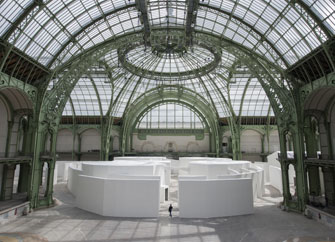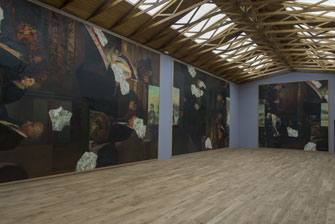Worshipping at
The Church of Art

“L’Etrange Cité,” by Ilya and Emilia Kabakov for “Monumenta 2014.” Photo: Didier Plowy pour la Réunion des Musées Nationaux-Grand Palais
Each year, for the event called “Monumenta,” a single artist is invited to fill the entire gorgeous but unmanageably vast glass-domed space of the Grand Palais with a site-specific work. This year’s invited artists are Ilya and Emilia Kabakov, whose installation, “The Strange City,” takes an approach very different from those of their predecessors (e.g., Anish Kapoor’s gigantic balloon, Richard Serra’s sky-high steel blades and Anselm Kiefer’s colossal monuments in ruins).
At a press conference last week, Emilia Kabakov (Ilya did not attend) admitted that the couple had been intimidated by the sheer size and “blinding light” of the space. Their response was to create enclosed spaces within the cavernous hall by building a series of simple, white-painted structures.
A little background on the Kabakovs, for those who are not familiar with their work. Ilya Kabakov (b. 1933) was an official Soviet artist who gradually went unofficial and emigrated in 1987. In 1992, he married the Russian-born curator and art dealer Emilia (née Kanevsky, b. 1945), with whom he had been collaborating since 1988. The couple now lives on Long Island.
While best-known for his conceptual installations, Ilya is a classically trained artist who, according to Emilia, never stopped painting. His earlier work dealt with life in the Soviet Union (a wonderful installation re-creating a communal kitchen in Moscow can be seen in the basement of the Musée Maillol in Paris), but the couple’s work now deals more with the human condition in general.
Before entering the “city” the Kabakovs have created for “Monumenta,” visitors are confronted with a huge dome lying on its side, as if part the roof of the Grand Palais had fallen to the ground. After passing through a sort of triumphal arch in ruins and crossing the corridor that surrounds the “city,” they enter the first building, “The Empty Museum,” which could be a room in the Louvre, but with nothing in it except benches to sit on. The paintings have been replaced with music: Bach’s “Passacaglia.”
The other buildings contain installations called “Manas,” “The Center of Cosmic Energy,” “How to Meet an Angel” and “The Gates.” The show ends with two chapels, one white and one black.
Each installation treats a topic with multiple versions of the same imagery, in three-dimensional models, drawings, paintings and text. The self-descriptive “How to Meet an Angel” features a wooden model of a man with a backpack making the long climb up a ladder to the sky to reach the angel hovering above, along with numerous drawings of the same subject and a pair of feathery white wings mounted on the wall with instructions for making your own.
As might be evident from the above, the installation has a strong metaphysical bent. Each unit appears to be about moving from one world to another—passages in life and passages to a world beyond. The structure called “The Gates” is all about tunnels, calling to mind accounts of near-death experiences in which the individual moves through a tunnel toward a light at the end. This room is lined with a group of near-identical paintings by Ilya Kabakov; while the colors vary, each one has a tunnel subtly worked into the otherwise abstract surface.
“Manas” deals wryly with the concept of Utopia through a model of an ideal Tibetan city reflected in the heavens, while “The Center of Cosmic Energy” imagines a machine that can capture cosmic energy from the heavens.
The walls of the chapels at the end of the “enchanted city” are painted with Ilya’s

“The Black Chapel.” Photo: Didier Plowy pour la Réunion des Musées Nationaux-Grand Palais
fractured images of people and places, which appear to represent the memories of a life fading to white or being blotted out by black shapes in a premonition of death.
This “Monumenta” is not visually spectacular, as most of the previous ones were, but its treatment of the human tendency to search for utopias and saviors – whether in art, politics, religion or elsewhere – is touching and thought-provoking. Before you leave, I recommend a return visit to “The Empty Museum” to reflect peacefully on what you have seen.
Galeries Nationales du Grand Palais: 3, avenue du Général Eisenhower, 75008 Paris. Métro: Champs-Elysées Clemenceau. Tel.: 01 44 13 17 17. Open Sunday, Monday, Wednesday, 10am-7pm; Thursday-Saturday, 10am-midnight. Closed Tuesday. Admission: €6 (Free on May 17, 8 PM-midnight). Through June 22, 2014. www.grandpalais.fr
Reader reaction: Click here to respond to this article (your response may be published on this page and is subject to editing).
Please support Paris Update by ordering books from Paris Update’s Amazon store at no extra cost. Click on your preferred Amazon location: U.K., France, U.S.
More reviews of Paris art shows.
© 2014 Paris Update
Favorite